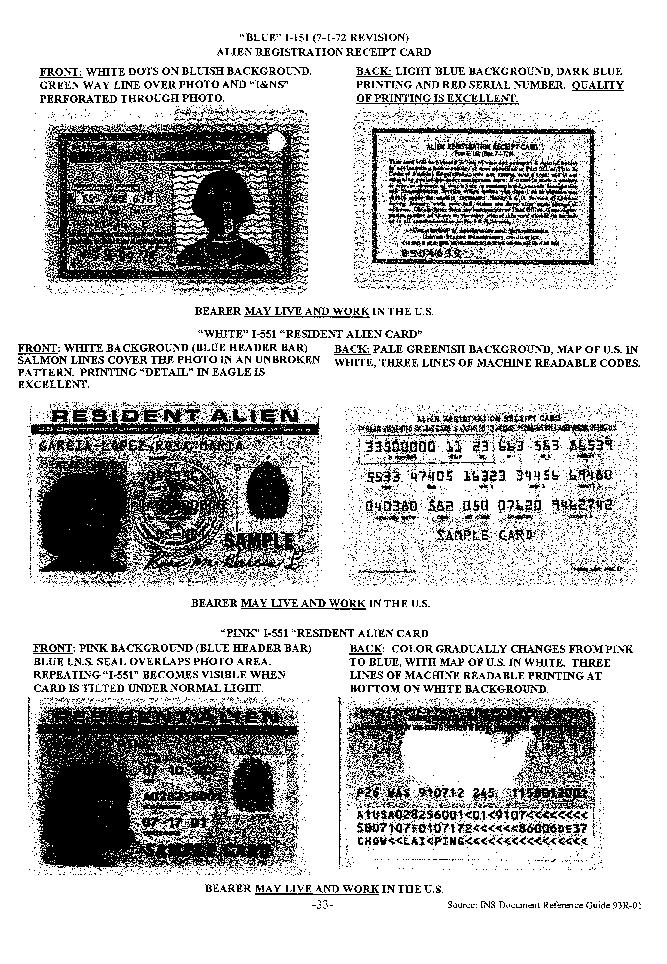
Appendix I
OBJECTIVES, SCOPE AND METHODOLOGY, AND BACKGROUND
The Office of the Inspector General (OIG), Audit Division, has completed an audit of the replacement of resident alien identity cards by the INS. The purpose of the audit was to assess the management of identity card replacement, which resulted in estimated collections from applicants of about $52 million19 in FY 1995.
OBJECTIVES
The objectives of the audit were to:
SCOPE AND METHODOLOGY
The audit was performed in accordance with generally accepted government auditing standards and included tests and procedures necessary to accomplish the objectives. However, we may not be considered by others to be completely independent of the INS as required by the standards, because the INS has reimbursed us for work that pertained to INS fee-supported programs. The Office of Management and Budget and the Department of Justice (including the OIG, INS, and Justice Management Division) disagree with the INS funding our work and are attempting to have the funds appropriated directly to the OIG. In FY 1996, the OIG received $5 million for fee-related audits, investigations, and inspections. That dollar amount funded about 14 percent of the total OIG staff positions. Nonetheless, we consider ourselves independent, and do not believe that our reimbursement arrangements with the INS had any affect with regard to our conduct of this audit.
During the audit, the INS awarded a 3 year contract valued up to $275 million to purchase new identity card production technology. We reviewed the provisions of the contract to manufacture at least four types of identity cards on a new card production system.
Throughout this report we used the INS strategic plan, Toward INS 2000, Accepting the Challenge, completed in November 1994, as our criteria for measuring INS performance toward achieving goals and objectives. A strategic plan is required by the Government Results and Performance Act of 1993. The INS completed the plan well ahead of the September 1997 date required by the Act.
We conducted the audit by reviewing and comparing prescribed operating procedures to actual operations, analyzing selected documents, performing tests of data on a sample basis, and interviewing program officials. We performed audit work at: INS Headquarters; the Forensics Document Laboratory; the Immigration Card Facility; the California, Nebraska, Texas, and Vermont Service Centers; district offices in Atlanta, Chicago, Miami, New York, Los Angeles, San Francisco, and San Diego; and ports of entry in San Francisco and San Ysidro. We focused on identity card replacement activities during 1995. We did not test the initial issuance of INS identity cards by way of immigration visas and adjustments of status.
At the California, Texas, Nebraska, and Vermont INS Service Centers, we interviewed center directors to determine staffing and funding levels allotted for the I-151 replacement process. Estimates or physical counts of backlogged applications were determined and we judgmentally selected 25 applications awaiting adjudication for the period of January through August 1995. The INS CLAIMS and CIS databases were tested for accuracy by judgmentally selecting a sample of 30 applications and comparing the application data input by contracted personnel to the applications.
At INS district offices in Los Angeles, Dallas, New York, Atlanta, Miami, and Chicago, we: (1) ascertained the staffing levels prior to and after the I-151 replacement program in 1992, (2) determined the types and amounts of backlogged applications by judgmentally selecting 25 replacement applications per location, (3) judgmentally selected a sample of 70 replacement applications that had been rejected by both the service centers and the Immigration Card Facility, (4) judgmentally selected 30 employer sanction cases to determine number and types of counterfeit cards used to obtain employment, and (5) reviewed up to five investigative files from fraud unit case files that contained significant counterfeit document seizures made during FY 1992 through FY 1995.
Through observation and interviews with supervisory personnel we determined how and when related INS databases were used and updated.
We interviewed management officials from the Social Security Administration, and state welfare and motor vehicle offices to determine the type of documents necessary to obtain benefits. For the most part, we conducted these interviews in the cities and states where we reviewed the INS district offices.
We obtained information from the U.S. Commission on Immigration Reform and attended a Subcommittee on Government Management, Information, and Technology, hearing on March 7, 1995, regarding integrity of government documents. We reviewed testimony of the Subcommittee on Immigration and Claims, provided by the Committee on Worksite Enforcement of Employer Sanctions on March 3, 1995.
We obtained and analyzed GAO, OIG Audit and Inspection reports and Congressional subcommittee testimony on subjects related to identity cards. Some of these reports are summarized beginning on page 35.
Computer Generated Data - Financial Systems
To achieve the audit objectives we relied on computer-processed data contained in the STARS (reports maintained by ICF to track the production of the I-551 and the BCC) and financial management information system. Prior reviews of INS automated systems and audits of financial statements found error rates that cast doubt on the data's validity.
However, when the data we used are viewed in context with other available evidence, we believe the opinions, conclusions, and recommendations in this report are valid.
To determine program costs, we obtained estimated and projected cost data from the INS financial accounting system and contract documents. The INS accounting system does not accumulate revenues and costs by type of benefit application. As a result, we used estimated data in this report. The accounting system accumulated costs related to the I-151 replacement program, which we were able to use to estimate replacement processing costs.
BACKGROUND
The mission of the INS is to administer and enforce the Immigration and Nationality Act, as amended, and other laws relating to the immigration and naturalization of noncitizens. The Commissioner of the INS has authority to carry out national policy allowing selective immigration, controlled entry, and stay of nonimmigrants to promote reunification of families, entry of immigrants possessing needed skills, temporary admission of specific classes of noncitizens, and refuge from persecution.
The INS has had a steady growth in responsibilities and resources in order to accomplish its mission. The funding for INS comes from both appropriated funds and user fee20 revenue. Separate accounts are maintained for each of the assessed fees and fee revenue can be carried over from one year to the next. At the end of each fiscal year, account balances along with estimated revenues are calculated to determine the capital available for the following year. The INS operating budget for FY 1994 was about $1.6 billion, of which over $533 million (33 percent) was collected from user fee revenues. The INS operating budgets for FY 1995 and FY 1996 are about $2.1 billion and $2.6 billion, respectively. The INS has over 20,000 permanent employees.
The INS receives and processes over 4 million applications and petitions for benefits annually at 4 service centers, 33 district offices, and over 200 ports of entry. INS district offices are responsible for the processing of applications, which require face-to-face interviews. Service centers process applications that are mailed.
Identity Card Laws and Regulations
The Alien Registration Act of June 28, 1940, contained the first requirement for the registration and fingerprinting of aliens. The Act was initially a temporary measure, but was made a permanent part of the immigration law by the Act of 1952. Sections 261 and 262 of the Act require the registration and fingerprinting of all aliens 14 years of age or older who are either in the United States for 30 days or longer or who are seeking to enter. Section 264 of the Act directs the preparation of registration and fingerprint forms, states certain information that must be solicited on these forms, and requires the safeguarding of information obtained. This section also directs that a certificate of alien registration or an alien registration receipt card is to be issued to each registered alien and requires that every alien 18 years or older carry his or her form of registration.
Identity Card History
The INS has issued identity cards since the early 1950s to control benefits and services available to legal resident aliens. By 1975, there were 17 versions of the identity card. This caused INS officials to express concern about the ability of INS inspectors to recognize valid cards. Adding to their concern was the possibility that Congress would enact employer sanctions legislation requiring the nation's employers to verify that employees hired are eligible to work in the U.S. As a result the INS determined that the 17 versions of the card would have to be replaced with one card to facilitate recognition of genuine documents by INS inspectors and employers.
In 1978 the INS received funding to create a secure verification system with an automated database and a fraud-resistant resident alien card, and implemented the Alien Documentation, Identification, and Telecommunications system. The INS estimated that the I-151 card would be replaced with a new card, called the I-551, within seven years. However the replacement process was not completed until March 1996.
The 1986 Immigration Reform and Control Act (IRCA) mandated verification of public
benefits eligibility to INS databases and prohibits any person from knowingly hiring an
alien who is unauthorized for employment. The INS was charged with responsibility for the
enforcement of employer sanctions. Enforcement of the sanctions has proven difficult, in
part, due to the 29 acceptable identity documents, which increased the difficulty for
employers in determining the authenticity of documents presented. Examples of three INS
documents acceptable as proof of identity and employment authorization are shown in
Figure 1.

As recently as 1989, the INS paid about $7.4 million21 for card production equipment to upgrade the I-551 card. In 1992, the INS received authority to reprogram $46 million in a continuing effort to implement the I-151 replacement program. The process was to have taken about 2 years to complete; however, due to a class action lawsuit and other complications, the INS extended the validity of the I-151 card to March 20, 1996.
In 1994, the INS awarded the Information Technology Partnership (ITP) contract to Electronic Data Systems Inc. Subsequently, the INS awarded five additional automation contracts. The six contracts, representing a total expenditure of approximately $525 million, will be utilized concurrently to implement seven Information Technology Programs with life-cycle costs of an estimated $2.3 billion.22
Of the six contracts, two Information Technology Programs, the Examination Systems and Corporate Information Systems programs, were determined to be related to identity cards. The life-cycle costs of these two programs were an estimated $400 million.23
Under the Examination Systems Program, projects related to identity cards include the Centralized Document Production Project and the CLAIMS24 Re-Engineering Project. The Centralized Document Production Project pertains to the development of the identity card Functional Requirements Document and technological evaluation. The Re-Engineering Project involves upgrading CLAIMS at the service centers, transfer of Immigration Card Facility (ICF) functions migration, and direct mail expansion.
Under the Corporate Information Systems Program, the status verification systems (TVS, ASVI, SAVE) and the Corporate Information Project will serve to integrate existing databases such as the Central Index System (CIS).
Immigration Reform Commission
The U.S. Commission on Immigration Reform was created by Congress to assess U.S. immigration policy and to make recommendations regarding its implementation and effects. Mandated by the Immigration Act of 1990 to submit an interim report in 1994 and a final report in 1997, the Commission has undertaken public hearings, fact-finding missions, and expert consultations to identify major immigration issues facing the United States today.
In the 1994 interim Report to Congress, the Commission recommended the development and implementation of a simpler, more fraud-resistant system for the verification of employment authorization. The Commission found the current system to be doubly flawed, as the system is too susceptible to fraud, particularly through the counterfeiting of documents.
In examining the options to improve verification, the Commission found the most promising option for secure, nondiscriminatory verification to be a computerized registry, using data provided by the SSA and the INS. The Commission has stated that the key to this process is the social security number.
The Commission believes the computerized system is the most promising option because it holds great potential for accomplishing:
The Commission states that while it supports INS' efforts to improve the TVS and SAVE databases, it believes these systems should be used only as interim measures. Although the systems are essential for improvement of data, the systems are inadequate as long-term measures due to the requirement that workers attest to their citizenship or alienage, thus making it easy for aliens to fraudulently claim U.S. citizenship. If a registry is implemented, there will be no need to use the identity card to document authorization for employment.
Prior Reports
The DOJ Internal Audit Staff performed audits on the INS program to replace the I-151 Alien Registration Card and disclosed deficiencies related to the database systems. The July 1979 audit report, Alien Documentation, Identification, and Telecommunications System, noted that the database was not accurately maintained. INS did not institute formal procedures to assure the proper management, coordination, and control of information produced by data processing systems would directly support INS' enforcement mission and administrative activities.
A report issued by the Audit Staff, JMD, in October 1987, I-551 Card Processing Controls noted that the INS database, specifically CIS, was an inadequate information source. The report stated that the improvement of the reliability of the database systems would not only enhance the ability of the INS to accomplish its mission but would also be useful to many other state and federal agency users of the SAVE and TVS programs.
GAO conducted a review of the INS management information system and disclosed in a September 1990 report titled Information Management, INS Lacks Ready Access to Essential Data that the current database systems did not meet INS' information needs, as information in the databases was often inaccurate or incomplete.
An October 1993 report issued by the Records Systems Division of the INS on the TVS Pilot program indicated that in order to effectively prevent the employment of illegal aliens, the INS must maintain a current and accurate database for employers to access. The results of the pilot program indicated that a significant number of manual searches for status verification were conducted. Costs for conducting a manual search could have been avoided if INS had maintained their databases on a current basis.
An OIG Inspection report, Systematic Alien Verification for Entitlements (SAVE) Program in the Immigration and Naturalization Service, dated June 1995, noted that verification often required a secondary check due either to inaccuracy of the data or to an absence of necessary data in the database. The report also noted that a 1991 State of Michigan Department of Social Services report concluded that the SAVE database is both incomplete and inaccurate, as well as difficult for public assistance agencies to use.
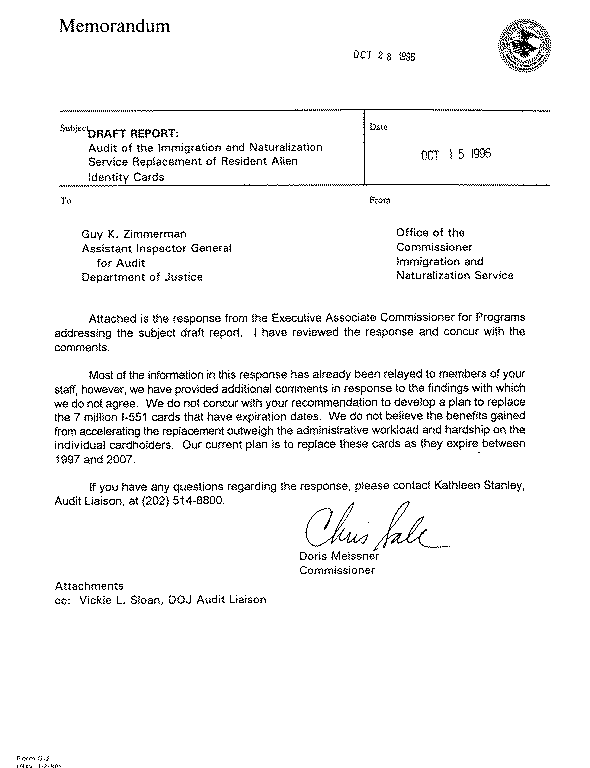
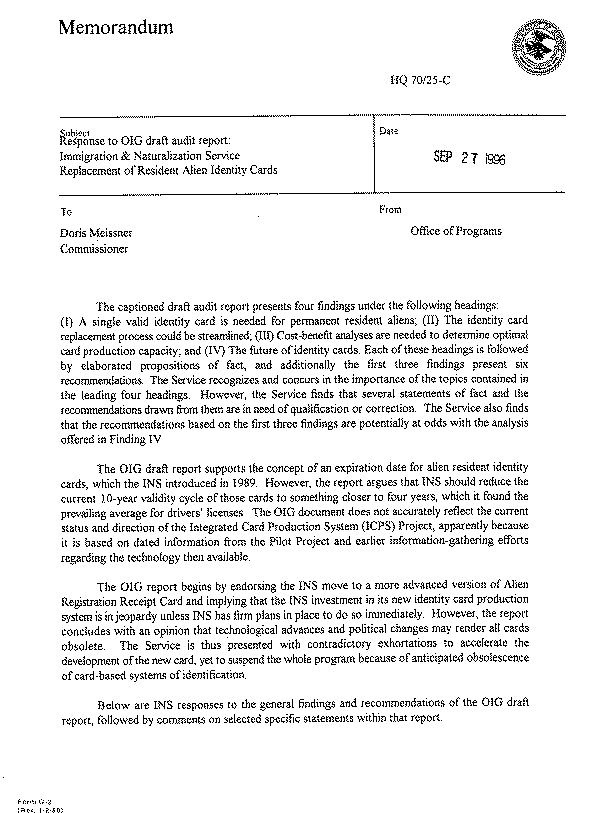
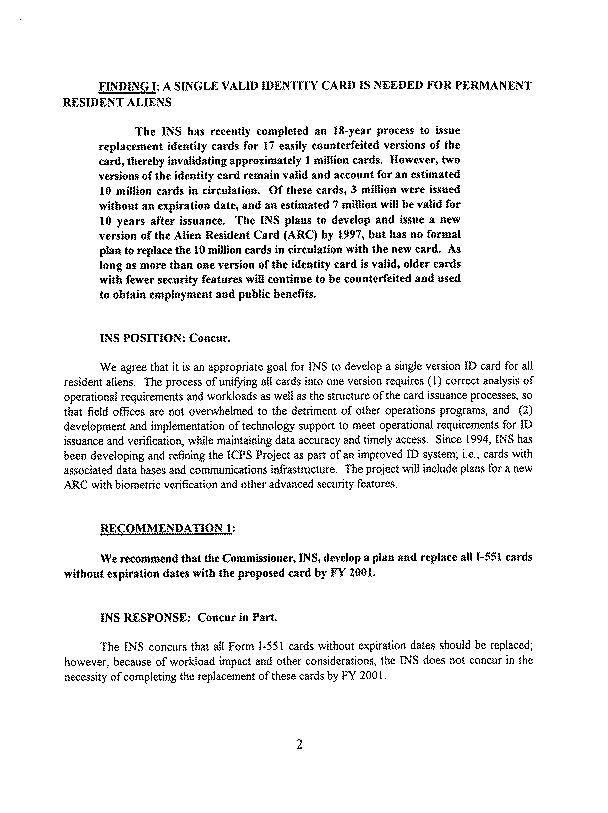
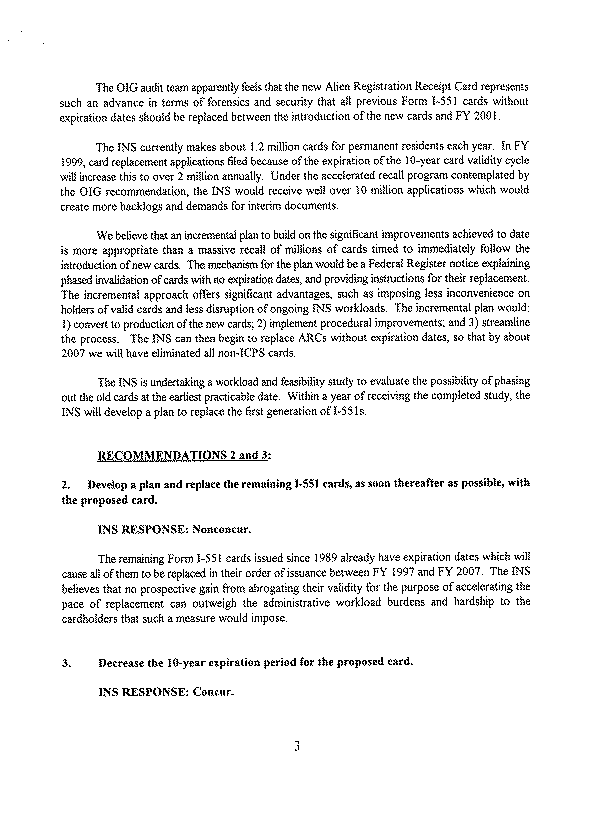
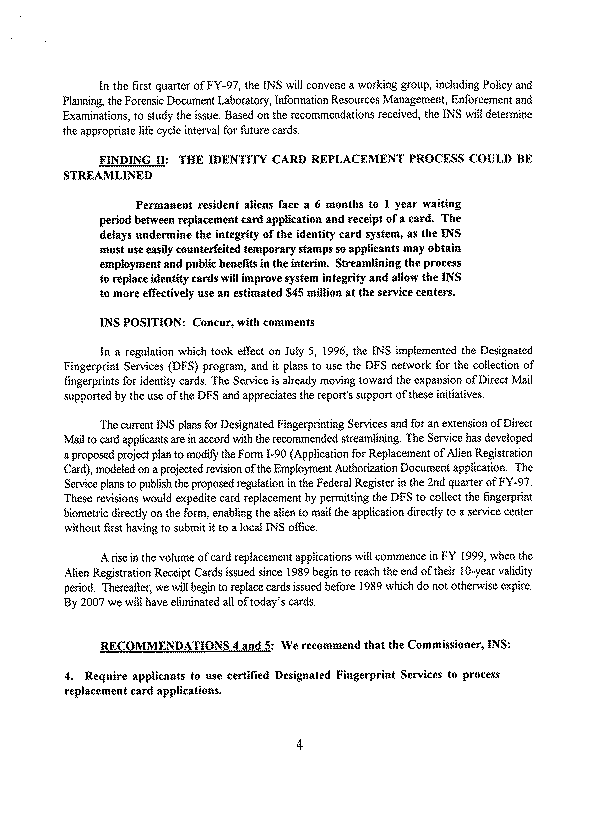
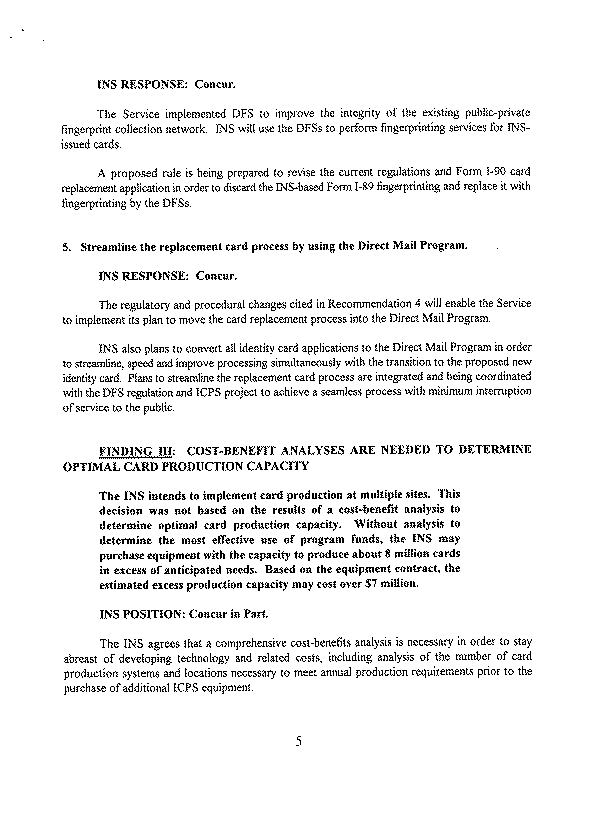
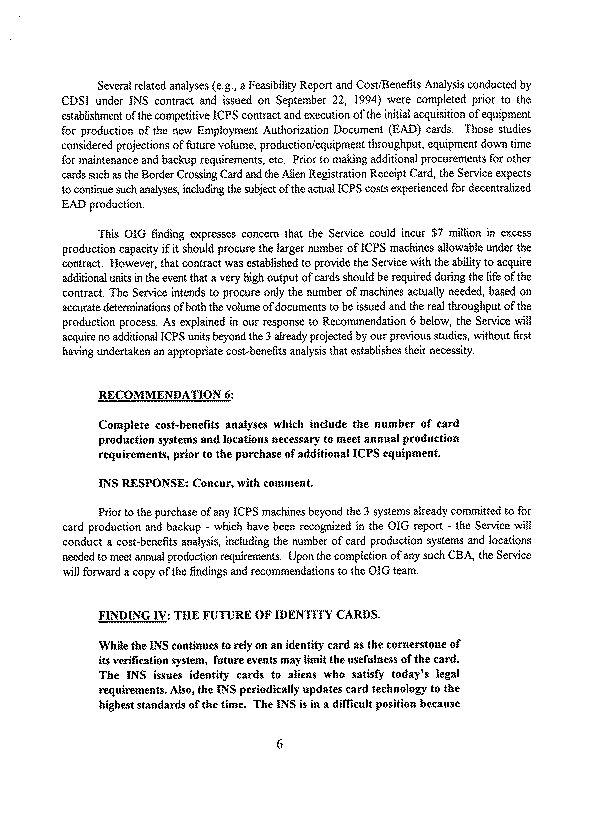
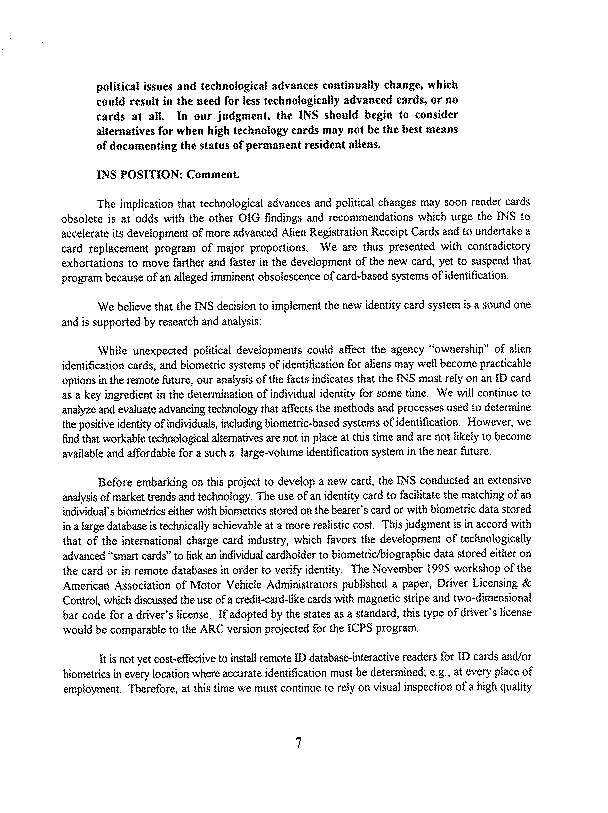
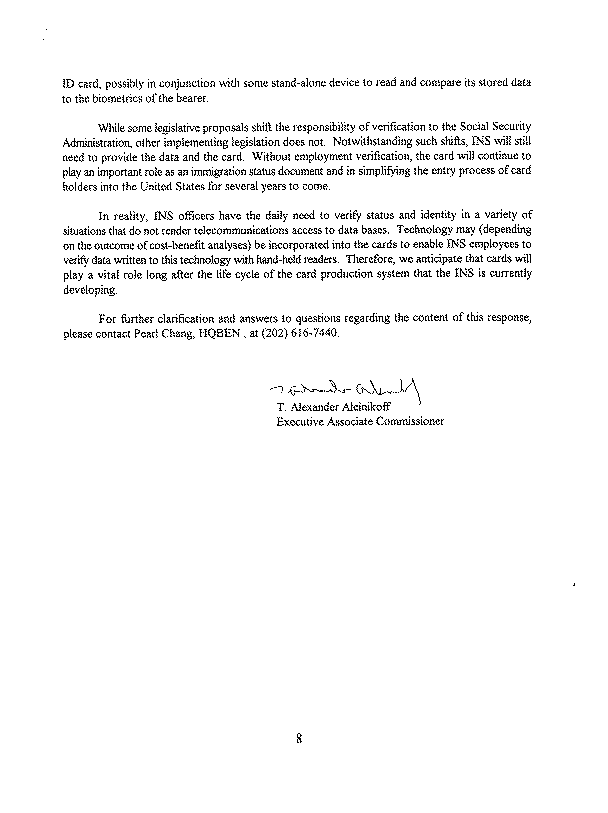
OFFICE OF THE INSPECTOR GENERAL, AUDIT DIVISION
ANALYSIS AND SUMMARY OF ACTIONS NECESSARY TO CLOSE REPORT
Recommendation Number:
We believe the timeframe recommended for replacement allows the INS ample time to develop a plan incorporating streamlined replacement procedures and a realignment of personnel, which will enable successful completion of the recommended replacement. The cost of replacing identity cards is recovered by the INS through applicant user fees, which will finance the additional costs associated with the replacement. This recommendation can be resolved when the INS either agrees to develop a plan and replace all identity cards without expiration dates by FY 2001, or proposes alternative corrective action that satisfies the intent of the recommendation.
The cost-benefit analyses should include the minimum number of card production systems needed, the different technologies considered, the production options of one location versus production in multiple locations, and a determination of annual production requirements. Our review of prior analyses performed by the INS indicated that these were dated and not currently useful for managers to make informed decisions. In our judgment, cost-benefit analyses are not a one-time exercise to satisfy regulatory requirements. Rather, cost-benefit analyses should be a dynamic process performed throughout the planning and implementation phases of the proposed system. This recommendation can be resolved when the INS agrees to perform the cost-benefit analyses prior to the purchase of additional ICPS machines over the two purchased as of our audit.
OIG Note on Finding IV
While INS read Finding IV as contradictory to Findings I through III, we do not see a contradiction. Finding IV is future oriented, while the other findings address current issues. Finding IV was intended to prompt INS managers to begin to consider future alternatives to card based verification systems. Eventually, the current ICPS production equipment will be rendered obsolete by new technology, if the need for a technologically advanced card is not diminished by legislative changes before then. At that time, INS will be faced with the decision of determining the best means of establishing resident alien identity. INS managers should now begin considering and exploring future alternatives that may replace the current card based verification system.
19 We estimated replacement card applications represented approximately 54 percent or 700,000 of the 1.3 million resident alien identity cards processed ($75 per replacement application x 700,000 = $52.5 million).
20 Section 9701 of Title 31 U.S.C. provides for federal agencies to recover the full cost of rendering a service provided to an identifiable recipient, or to unique segments of the population, by imposing a charge for the service rendered.
21 Based on estimated cost of Immigration Card Facility production equipment.
22 Based on costs identified in the quarterly report of the INS Automation Initiatives, dated July 1996.
24 The Computer Linked Application Information System (CLAIMS) is used to receipt fees and track applications for immigrant benefits. The system is operational at the four service centers, the Baltimore District Office and the Administrative Appeals Office.
#####